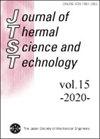循环热管蒸发器最佳微槽形状的数值研究
IF 0.9
4区 工程技术
Q3 THERMODYNAMICS
引用次数: 1
摘要
环形热管是由多孔介质中的毛细压力和工作流体的气液相变驱动的传热装置。lhp广泛应用于航天器的电子冷却系统(Okamoto et al., 2016)、绝缘栅双极晶体管(Dupont et al., 2013)、笔记本电脑(Lin et al., 2013)和其他热工应用。如图1所示,LHP由蒸发器、冷凝器、蒸汽管线、液体管线和补偿室(CC)组成。与传统的热管不同,该热管芯被封闭在蒸发器中,可以实现长传输长度和大辐射区域。Maydanik(2005)、Ku(1999)和Launay et al.(2007)综述了lhp的工作特点和工作机制。灯芯形状以及多孔材料和毛细管结构对蒸发器的性能有重要影响,但灯芯形状的设计较为复杂,本文对此进行了重点研究。一些论文试图通过参数化研究来提高蒸发器的传热系数,这些参数包括圆柱形或平面蒸发器的形状(例如,机匣与灯芯之间的接触面面积、凹槽数量、凹槽宽度、凹槽间距、凹槽横截面形状、凹槽位置(在灯芯或机匣中)和灯芯厚度)(North et al., 1997;Riehl et al., 2008;Kiseev et al., 2010;Yakomaskin et al., 2013;Yakomaskin, 2016;Kuroi and Nagano, 2012;Hodot et al., 2013;Wu et al., 2014;田,2014;Zhang等人,2012)。特别是,通过在灯芯表面形成微槽,传热系数显著提高(North et al., 1997;Riehl et al., 2008;Kiseev et al., 2010;Yakomaskin et al., 2013;Yakomaskin, *日本爱知市丰桥市天paku町Hibarigaoka 1-1号机械工程系**目前就职于松下公司1006,日本大阪多马市小坂多马市571-8501 ***伍斯特工业大学机械工程系,美国马萨诸塞州伍斯特研究所路100号,01609,E-mail: nishikawara@me.tut.ac.jp本文章由计算机程序翻译,如有差异,请以英文原文为准。
Numerical exploration of optimal microgroove shape in loop-heat-pipe evaporator
A loop heat pipe (LHP) is a heat transport device driven by capillary pressure in porous media and the vapor–liquid phase change of a working fluid. LHPs are widely used in the electronic cooling systems of spacecraft (Okamoto et al., 2016), insulated gate bipolar transistors (Dupont et al., 2013), laptops (Lin et al., 2013), and other thermal engineering applications. As shown in Fig. 1, an LHP consists of an evaporator, a condenser, a vapor line, a liquid line, and a compensation chamber (CC). Unlike conventional heat pipes, the wick is enclosed in the evaporator, enabling long transport lengths and large radiation areas. The operating characteristics and working mechanisms of LHPs are reviewed in Maydanik (2005), Ku (1999), and Launay et al. (2007). The wick shape as well as porous materials and capillary structures critically affects the evaporator performance, but the design of the wick shape is complicated, which is focused in this paper. Some papers have attempted enhancement of the evaporator heat-transfer coefficient by parametric studies with respect to the shape (e.g., contact surface area between casing and wick, groove number, groove width, groove pitch, groove cross-sectional shape, groove location (in a wick or casing) and wick thickness) with a cylindrical or flat evaporator (North et al., 1997; Riehl et al., 2008; Kiseev et al., 2010; Yakomaskin et al., 2013; Yakomaskin, 2016; Kuroi and Nagano, 2012; Hodot et al., 2013; Wu et al., 2014; Uchida, 2014; Zhang et al., 2012). Especially, the heat-transfer coefficient was significantly improved by forming microgrooves on the wick surface (North et al., 1997; Riehl et al., 2008; Kiseev et al., 2010; Yakomaskin et al., 2013; Yakomaskin, *Department of Mechanical Engineering, Toyohashi Univ. of Tech. 1-1, Hibarigaoka, Tempaku-cho, Toyohashi, Aichi 441-8580, Japan **currently at Panasonic Co. 1006, Oaza Kadoma, Kadoma-shi, Osaka 571-8501, Japan ***Department of Mechanical Engineering, Worcester Polytechnic Inst. 100 Institute Road, Worcester, MA, 01609, USA E-mail: nishikawara@me.tut.ac.jp
求助全文
通过发布文献求助,成功后即可免费获取论文全文。
去求助
来源期刊
CiteScore
2.30
自引率
8.30%
发文量
0
审稿时长
5 months
期刊介绍:
JTST covers a variety of fields in thermal engineering including heat and mass transfer, thermodynamics, combustion, bio-heat transfer, micro- and macro-scale transport phenomena and practical thermal problems in industrial applications.

 求助内容:
求助内容: 应助结果提醒方式:
应助结果提醒方式:


